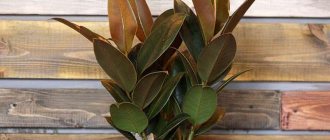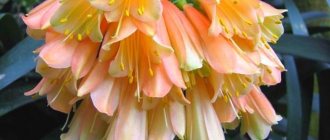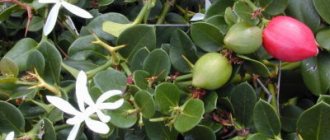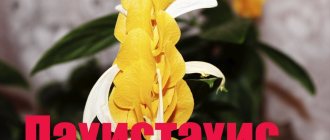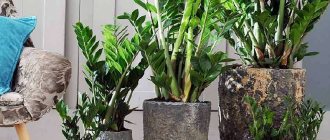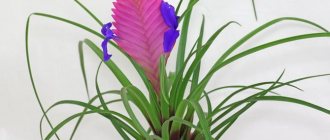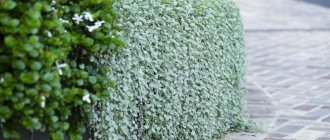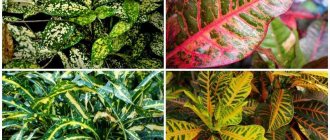Schefflera: care at home
Flower growers prefer the plant due to its beautiful, showy leaves that look like a human palm. The leaf blades are located at one point and resemble umbrellas. In the West, the crop is called the gnome umbrella or the umbrella tree. The culture branches like Benjamin's ficus. That is why bonsai lovers grow it as a home solitaire plant. Often trees of various shapes are formed from it. The culture has a small stem thickness, so it is planted several units in one pot. The stems are tied together to form a common trunk, which is intertwined. If it is a single tree, then it needs support due to its very thin stem.
Schefflera, home care:
- Schefflera is easy to grow indoors because it is unpretentious. Contains substances that, upon contact with the mucous membrane, may cause an allergic reaction or irritation.
- Therefore, pruning and watering should be done with gloves. Flowers prefer light; during the cold season, the shefflera is placed on the windowsill, which is located on the south side of the room. However, in the summer it is necessary to remove it, protecting it from ultraviolet radiation. Usually it is located near the window, in the southern part of the room.
- The culture grows well on the western or eastern side. Please note that in a room where there is little light, the culture does not feel well. If the apartment faces a shady side, you should choose varieties with dark green foliage. Varieties that are distinguished by variegated and bright leaves love light. It loves humidity, so it adapts well to the conditions in the house. It is necessary to constantly spray the settled water. It is necessary to maintain the temperature within 23-26 degrees.
- Watering should be constant, but it is impossible to fill the shefflera. It is necessary to use settled water to prevent the soil lump from drying out. In winter, the amount of watering is reduced. Do not allow the water to stagnate. As a result, rotting may occur and the crop will quickly disappear.
Umbrellas
Schefflera arboricola care. Schefflera species
Schefflera arboricola
A flowering evergreen shrub that came to our region from the islands of Hainan and Taiwan. In its homeland, the plant with an erect, branching trunk reaches four meters in height. The leaves are compound, palmate, with up to nine leaf plates measuring up to 20 cm in length and up to 10 cm in width. Young shoots of Schefflera arborescens are light green, and with age they become light brown.
Based on this species, new varieties have been bred: Amate - has very beautiful shiny waxy leaves, is less damaged by pests and is less demanding on lighting; the Gold Capella variety bears an incredible resemblance to a palm tree, whose green leaves are painted with small yellow spots.
Schefflera actinophylla (Schefflera actinophylla)
It is also called the “green star”. One of the most common types. Under natural conditions, this single- or double-stemmed plant reaches a height of fifteen meters. This ornamental tree grows well in gardens and greenhouses in a warm, mild climate.
In indoor conditions it can reach a height of 2.5 m. On the gray-brown erect trunk there are red-brown long petioles majestically bearing bright green, shiny, large leaves. They consist of 8 – 15 independent leaf blades. The length of the elegant serrated leaves reaches 60 cm. Small bright red flowers form inflorescences, the result is clusters of purple fruits.
Schefflera octophylla (Schefflera octophylla)
Tropicana from humid mixed Indian, Japanese and Chinese forests. Here, Schefflera octophyllum trees or shrubs reach a height of 15 m.
Original light green rosettes of 8-11 glossy, leathery, oval leaf blades are located on drooping cream thirty-centimeter petioles. The reverse side of the leaves is matte green. In late autumn, the plant is decorated with inflorescences of white flowers, and by December the fruits appear.
Matches made from soft wood plants are in demand. Traditional medicine treats colds, bruises, and injuries with the help of an infusion of leaves and root bark of Schefflera octophylla.
Schefflera Janine
The variegated beauty has gained popularity due to its unpretentiousness when growing. Grows well in the shade, maintaining the bright green leaves and dark, chaotically located contrasting stains and inclusions.
Schefflera Nora
Flower growers increasingly like Schefflera Nora’s elegant foliage and ease of care. A lush crown of long, narrow, light olive leaves with yellow splashes can create coziness and a positive atmosphere in the house.
Scheffler Luzeana
The very elegant Shefflera Louisiana is absolutely not demanding in care. By following only the general rules of cultivation, you can tirelessly admire its decorative openwork leaves. When the plant is placed in a sunny room, its leathery, shiny leaves will become even more variegated with yellow or white splashes.
Schefflera Gerda
This variety does not require special care. In diffused light, it will feel great and can reach up to 2.5 m in height. Variegated Tropicana, from white-green to yellow-green colors, will be grateful for moderate soil moisture and normal room temperature within 16-20˚C.
Schefflera Charlotte
More recently, breeders have developed the Schefflera variety Charlotte. Landscape designers plant this beauty in office and residential spaces.
The light leaves of Schefflera Charlotte have a dark green edge on the outside. On the other hand, the leaf has a darker and more saturated color.
Schefflera digitata
Schefflera palmata comes from the tropical forests of New Zealand, where its height can reach eight meters. The leaves of the plant, divided into 7-10 palmate, soft and thin plates with pointed tips, are very similar to palm leaves. Large flowers form a paniculate inflorescence, resulting in edible purple fruits - a favorite delicacy of birds and insects.
Locals use the juice of the flower to treat skin ulcers and ringworm. In ancient times, wood of this type was used by schefflers to make fire. Now the indigenous people are massively selling souvenirs and crafts from the plant to numerous travelers, so Schefflera digitata is on the verge of extinction.
Schefflera flower: home care, pruning
Needs pruning, thanks to this it becomes much more magnificent. As mentioned above, often several seedlings are transferred to a pot so that they intertwine with shoots, thickening the stem. The crop takes on the shape of a tree thanks to regular pruning.
Schefflera flower, home care, pruning:
- However, if pruning is not done according to the rules, it can cause harm and cause the death of the crop. Falling leaves indicate improper care. However, you shouldn’t be upset; perhaps the flower can be saved.
- Perform low pruning, almost to the very root. This may work if the root system is healthy. The stump is watered and covered with damp moss so that the upper part of the cut does not dry out. If the manipulation is performed correctly, you will soon see young shoots.
Bonsai
Strict watering regime
You need to carefully monitor the condition of the soil in the pot. Schefflera reacts sharply to the slightest waterlogging of the earthen clod. Root rot forms very easily. However, you can’t overdry the flower either. If you see that the top layer of soil is drying out, water the plant a little.
To care for shefflera at home, use settled water slightly warmer than room temperature.
On particularly hot days, more intensive watering may be required. Norms range from once every 5 days to once every 2–3 days (for hot summers). Remember that everything is purely individual and depends on the degree of moisture evaporation and ambient temperature. After irrigation, be sure to drain excess water from the pan.
It is not recommended to replant Schefflera immediately after purchase.
It is necessary for the plant to get used to new conditions. If you want to change the soil of the flower, wait at least a month.
This culture is a big fan of high air humidity. To help it survive the summer and heating season without loss, often spray the leaves with water (settled, at the same temperature as for watering). It is also useful to periodically wipe the plates with a damp cloth. This way you will not only provide the necessary humidity, but also remove excess dust, which will make it easier for the plant to breathe.
If you don't have time to spray daily, replace it with a warm shower every two weeks.
Schefflera flower: winter care
Winter for shefleras is a period of rest and peace. It does not grow, does not produce new, young shoots.
Schefflera flower, winter care:
- In winter, you need to place the crop on the windowsill, in a bright place, at a temperature of 16 degrees.
- Watering is carried out once a week in winter.
- In the cold season, the temperature can be reduced to 18 degrees. The lowest limit that a plant can withstand is +12 degrees.
- The culture is not suitable for a winter garden or growing on a balcony. It should be protected from drafts and not placed near heating devices.
- In winter, if the crop is located near heating radiators, it must be sprayed regularly. Do not apply too much moisture to the root; it is better to do this with a sprayer. Allow the flower to feed through the leaves and stems rather than the roots. If the crop grows slowly and practically does not produce new shoots and leaves, this indicates a small pot.
- If the shefflera has not been replanted for a long period of time, be sure to transfer it to a larger pot in the spring. The plant is unpretentious, however, like any crop, it can be overcome by pests.
Eight leaf
Plant growing problems
The plant is susceptible to attack by aphids, spider mites and scale insects.
Diseases and pests can interfere with the healthy development of shefflers. It is susceptible to attack by aphids, spider mites and scale insects.
The intervention of aphids is clearly visible on the leaves of the plant: young leaves begin to turn yellow and fall off. To drive away the pest, you need to spray the flower with a soap solution. This same measure serves as an excellent prevention, which should be carried out once a week. But a soap solution does not always help.
If the plant is severely damaged, special preparations based on systemic action should be used.
To save the shefflera, you need to notice the signals she gives in time.
- If the leaves turn yellow and fall off, the reason for this may be a lack of lighting. Try placing the flower pot in a different place.
- Green leaves fall off, which means the plant is suffering from cold. You need to use warmer water for irrigation.
- Dry tips of leaves indicate that the air in the room is too dry.
- The leaves turn black and fall off - moderate watering by making it less frequent.
- Light spots on the leaves are burns from direct sunlight.
- Sheflera, who has stopped growing, complains of lack of nutrition.
In order for a healthy cheflera to be pleasing to the eye, you need to follow the rules for its care. Protect the flower from pests, maintain the required temperature conditions and maintain good lighting. One plant can be propagated in several simple ways that even an inexperienced gardener can handle.
Knowing the features of caring for tropical cheflera, you can enjoy its beauty for many years. A healthy plant will be decorated with dense, leathery leaves, and a carefully trimmed dense crown will fit perfectly into any interior.
Detailed video instructions for transplanting shifflera:
Noticed a mistake? Select it and press Ctrl+Enter to let us know.
Schefflera flower: home care, replanting
As for replanting, young plants need it annually.
Schefflera flower, home care, replanting:
- Every spring it is necessary to replant. Adult sprouts are transplanted as needed.
- This should not be done every year, but once every few years. The root system grows and may not have enough space in a cramped pot.
- The container for transplantation is selected several times larger than the previous one. Be sure to take care of drainage.
- It is worth using slightly acidic, light soil. A mixture consisting of peat, sand, humus in a ratio of 1:1:3 is selected. Sand and turf soil are often used in a ratio of 1:2.
Culture
Schefflera, what kind of soil and pot is needed. Planting, replanting, soil - the cheflera will not forgive mistakes
This unusual decorative foliage plant fascinates with its beauty and gives your interior a certain zest. Light green leaves on thin stalks resemble a ballerina and give the flower grace. Planting and replanting sheflera in the ground will not require much effort.
Schefflera: planting in spring
The most favorable period for planting sheflera is spring. As a rule, 4 young plants are planted in one pot at once. Don’t forget to place a 4cm high drainage at the bottom of the pot; prepared soil can be poured onto it.
Schefflera: transplantation according to the rules
It should be remembered that transplantation of “young” and “adult” plants occurs at different intervals - this plays a big role in the development of a decorative flower. So, a young plant should definitely be replanted in the first year of life. At this stage, the cheflera is growing quite actively and the root system completely fills the pot, so it becomes cramped. In the new pot, use fresh soil and place the plant on a wide layer of soil. To prevent voids from forming in the pot, gently press the soil so that the roots fit tightly to the ground. After replanting is completed, fill the plant with plenty of water.
The transplant period for adult sheflera varies from 2 to 5 years. If the bush is not small, then replanting is carried out without replacing the soil ball. To improve the health and create favorable growth for the flower, it is recommended to change the top layer of soil every spring; to do this, carefully remove the top 10 cm of soil and replace it with a new one.
Pay attention to the size of the pot: if the plant is large enough, then use a large container, and with each subsequent replanting it is necessary to change the pot; it should be larger, up to 5 cm in diameter. Using the method of transferring a branched plant will preserve its roots.
Schefflera flower: care, propagation at home
There are several ways to propagate sheflera. The crop can be grown by sowing seeds, cuttings, or air layering. Seeds can be purchased at garden centers. Sowing is carried out in January or February, that is, in the cold season. It is necessary to sow in a mixture of sand and peat, which are mixed in equal proportions. The seeds are kept in a weak solution of potassium permanganate to get rid of pathogenic microflora. After this, Zircon or Epin is administered.
Schefflera flower, care, propagation at home:
- These are growth stimulants that improve rooting and stimulate rapid growth. After sowing, it is necessary to moisten the soil with a sprayer and put it in a dark place at a temperature of 24 degrees.
- Be sure to cover the pot with glass or film to maintain a high level of humidity inside. Ventilate the soil and moisten it from time to time.
- Do not forget to provide air flow, because the surface may become moldy and pathogenic microorganisms will begin to develop. After you get two leaves, you need to transplant the seedlings into small pots.
Big leaves
Choosing your own method of reproduction
The plant propagates by seeds, cuttings and rooting of air layering. How to care for schefflera seedlings at home can be seen in the photo.
Seeds
Rarely does anyone succeed in bringing this plant to flowering and collecting seeds at home. But growing it from purchased grains is not as difficult as it seems. Sow seeds no later than January or February. They are pre-soaked in a zircon solution. The soil is usually taken the same as for an adult specimen. Once the seeds are located, moisten the substrate with a spray bottle. You can sow immediately in small pots or cups, so as not to waste time diving. Place each container in a bag and tie it. Ventilate your makeshift greenhouse for a few minutes from time to time.
Cuttings
Planting material is taken only from absolutely healthy plants. Find a fairly woody twig and cut it with a knife with a sharp blade (the tool must be treated with an antibacterial agent in advance). Next, place the cut shoot in a glass with a stimulant solution for approximately 5 - 7 hours. Then transfer to the prepared substrate. Provide greenhouse conditions and frequent ventilation. A photo of this stage of caring for shefflera at home can be seen above.
By layering
In spring, a small cut is made on the stem. The moss should be soaked in a solution of universal fertilizer and the cut should be carefully closed. A film is wound over the sphagnum moss. The moss is constantly kept moist. The first roots will appear no earlier than six months later. Then they wait about a couple more months until they get stronger. Then they cut off the top along with the roots and plant it in the ground. The remaining trunk is removed almost to the root. Watering does not stop. Over time, new shoots form. Important! The juice of the flower is poisonous. Do not allow it to come into contact with the skin and mucous membranes of the eyes. When shaping and cutting shifflers, all operations are best carried out with rubber gloves.
Possible difficulties in growing:
- The yellow color of the leaves is a sign of a lack of nutrients in the soil. Urgently feed the plant.
- The leaves fall, the shefflera does not grow - the temperature regime is disturbed, the pot is in a draft, or mistakes were made when watering.
- Curled, blackened leaves, the appearance of dropsy (the back side of the plate is covered with pimples) - the soil does not have time to dry out between waterings or unsettled water was used.
If you do not monitor air humidity and cleanliness of the plant, aphids, spider mites or scale insects may appear.
Without intervention, this plant practically does not branch. It is not difficult to form a shefflera crown at home.
Photos of how to do this can be seen above. This plant will be a real gift for any flower lover. In addition, it not only pleases the eye, but also cleanses the air of nicotine and toxic tars. And her colorful umbrellas will become a reliable shelter from the blues at any time of the year.
Secrets of keeping shefflera at home - video
Schefflera, home care
An interesting fact is that sheflera is popularly called “ umbrella tree ”. The plant received this name due to its leaves, which diverge in different directions like an umbrella. In addition, its leaves also resemble children's palms reaching for the light of the sun. Lovers of this indoor flower appreciate it for the extravagance and elegance of its green crown, rapid growth and impressive appearance. As a rule, with good care of the cheflera, this plant can please you with its height of up to 2 meters.
How to properly care for cheflera?
Schefflera flower: propagation by leaf
The easiest way to propagate is by cuttings.
Schefflera flower, leaf propagation:
- For this, lignified cuttings and upper parts of the stem are used. For rooting, planting is carried out in a mixture of peat and sand.
- The place where the cutting is cut is treated with growth and root stimulants, and the container is covered with film.
- The optimal temperature for growth is +22 degrees. Don't forget about ventilation.
Culture
Selecting optimal conditions and temperature conditions
If you don’t want to wonder why the cheflera isn’t growing, you just need to remember a few simple rules. Create such a habitat so that the cheflera flower feels more than comfortable. The best place for it will be sills facing west and east. If this is not possible, it will be enough to place it right next to the window, so that diffused sunlight falls on the flowerpot. It must be remembered that this delicate plant should avoid drafts . It is also an excellent condition that your home or office space has air conditioning. This will give a chance to make the optimal temperature in the room 18-22 degrees Celsius and at the same time the flower will grow much better and faster. But if there is no air conditioning in the room, you should know that then the flower needs to be additionally watered and sprayed with water.
Schefflera flower: signs
Schefflera is a plant that not all indoor plant lovers want to grow at home. Many believe that it is an energy vampire, interfering with the positive aura in the house. But esotericists and knowledgeable people claim that the flower only absorbs negativity, cleansing the house. It is recommended to install pots with plants in the bedroom. During sleep, a person's thoughts will be cleared and negativity will be absorbed. This will allow you to have a good rest and sleep. It is recommended to install the pot with the culture in the room of a schoolchild or student. This will improve your memory, and the learning process will be much faster and more successful.
Schefflera flower, signs:
- Sheflera can warn its owners about impending misfortune or unpleasant events. If the leaves curl, this indicates deception of someone close to you.
- If the leaves suddenly darken, the flower cannot cope with the negativity that is present in the house. Talk to your loved ones, try to resolve all problems without scandals. Don’t hide important information, don’t try to solve problems yourself, this will lead you to a dead end.
- If the plant has stopped producing new shoots and green leaves, financial stagnation or depression awaits you.
- It is a good sign if the crop grows quickly and produces a lush crown and a large number of green leaves. Esotericists are sure that this promises an increase in the family, perhaps the couple will have a child. They recommend installing in offices, caring for, fertilizing and watering. If the crop pleases with a large number of green leaves, this promises success and financial well-being. In the reception area of an enterprise, the plant is capable of absorbing negativity and protecting the office from ill-wishers.
Bonsai
The magical properties of sheflera
It is no coincidence that sheflera is used as an office plant. In addition to its neat and strict appearance, ease of care, it can attract money, luck, good partners and clients. Based on the state of the flower in the office, you can in some way talk about the state of affairs in the company.
Schefflera is considered the flower of knowledge, so it is recommended to place it on the desktop of schoolchildren or students. It is believed that it contributes to a better assimilation of knowledge and understanding of the subject.
“The Good Vampire” - a sheflera in a home or office not only normalizes the situation, but promotes harmony between spouses and the development of normal relationships in a business environment.
Soil for sheflera at home
An important step is the correct choice of soil. The culture prefers light, well-drained soils that allow air to pass through well.
Soil for sheflera at home:
- Among them, it is worth highlighting special soil for sheflera, or preparing it yourself.
- Mix turf, humus, leaf soil and sand. There are substrates that can be purchased at garden centers.
- They are designed for growing this plant.
Bush
How to defrost a shefflera. The most famous methods.
Today, many experienced gardeners know everything about how to propagate this unpretentious and simple plant. But for beginners in this business, our recommendations will be very helpful. So, the main methods of propagating cheflera at home are as follows:
- by propagation by cuttings;
- through seed germination;
- by propagation by layering.
In addition, it is important to remember that without knowledge of the specifics of caring for a cheflera flower, none of these methods will fully guarantee positive results.
The simplest of them is propagation of cheflera by cuttings . To do this, we recommend using semi-lignified cuttings, which are cut in the spring. Next, root the cuttings in water or take a substrate, for example, add sand (necessarily coarse-grained) to regular soil, follow the proportions 1:1. Before this, the places where the cuttings are cut need to be treated with a special root formation stimulator to make rooting easier.
If you use water for rooting, when the roots appear and develop (fastest in Schefflera, a solid green color; in variegated ones, after 4 weeks), plant the cutting itself in the ground, cover it with a bag, after making a hole for air to enter. But at the same time, do not forget to remove the bag every day 1-2 times, the plant should be ventilated for 20-30 minutes.
When rooting in the substrate, the bag should be put on immediately and ventilated according to the same scheme. Do not over-moisten the substrate; it should be kept slightly moist.
The second method is propagation of sheflera through seed germination . Unfortunately, cheflera cannot obtain the fruits of their seeds at home. Therefore, purchased seeds are planted in winter, mainly January-February, but also in March. The soil must be loose, air and moisture permeable. You can use two types of soil mixture that are perfect. We recommend peat with sand or a handful of sand and a liter of soil. The seeds go deeper into the ground about half a centimeter. Next, water, cover with film and place in a place with an acceptable temperature of 22-25 degrees Celsius. It is enough to ventilate the flower once a day, while removing the film. The pot where the seeds were sown must have drainage and a hole to drain excess water. When seedlings appear, the plant will require a brighter habitat. Create an air temperature within 15-17 degrees Celsius. When summer comes, do not forget to spray your baby cheflers with warm, not cold, water.
by layering will be interesting , provided that there is a large version of this flower. When spring comes, cut the trunk of the plant. It is important to wrap the cut area with a layer of green moss, and then cover it with a layer of film. The moss must be wet. After a month, maybe a little later, roots appear and then the stem can be cut off at the bottom of the new roots and planted in soil made from a 1:1 mixture of peat and sand. When the sheflera has new leaves, feel free to replant it in its usual place.
Just a few simple rules and recommendations and the chef will happily greet you with his open palms!
Elena Ivanova • 08/23/2018
Schefflera is a tropical plant that rarely blooms at home, but has interestingly shaped leaves. Schefflera got its name thanks to the surname of the famous botanist Scheffler. How to properly care for and propagate sheflera at home, why the “vampire” is kind and brings happiness and prosperity to the house - we’ll look at it in the article.
Schefflera leaves are turning yellow, what should I do?
The crop needs feeding, every week, starting in spring. It is worth alternating fertilizing, one week adding nitrogen and complex preparations for indoor crops, and the next time adding organic ones. In winter, the flower does not need fertilizer. During this period, the amount of moisture is reduced and fertilizers are not applied. It is recommended to reduce the temperature to give the culture rest.
Each owner of a houseplant independently decides when to fertilize and prune. Experts recommend trimming the top. After it, side leaves and branches will begin to grow. The plant will become more lush and voluminous. Leaves cut from the top can be placed in water and rooted. This will allow you to grow additional seedlings. By the condition of the leaves you can determine what the flower is missing.
Schefflera leaves turn yellow, what to do:
- If they darken at the tips, the crop does not have enough fertilizer.
- If the leaves dry out at the tips, it means the plant does not have enough moisture.
- If darkening is observed at the tips, stop watering. This indicates an excess of moisture.
- Yellowing of the crown indicates a deficiency of minerals and stagnation of moisture.
Fruit
Care and cultivation
Flowerpot option
The plant looks most advantageous in well-lit or dimly shaded spaces. In summer, it is advisable to protect Schefflera from the active effects of ultraviolet radiation - it causes the leaves to turn yellow and contributes to the shortening of the petioles.
The most favorable option for shefflera is to stay indoors in winter, and in the fresh air in summer - in the front garden, on the terrace or balcony. Flowerpots must be placed in a windless place.
Ground planting shefflera
Tree varieties of shefflera safely tolerate short-term cooling (up to +10 degrees Celsius), but it cannot be exposed to cold for any long period - then it begins to lose foliage.
It cannot be too hot for potted plants, but in this case the shefflera excessively lengthens the shoots and loses bushiness, which negatively affects its appearance. Therefore, the best temperature for flowerpot options is from 18 to 25 degrees C.
Schefflera diseases and their treatment
Below we will consider the most common ailments that affect the chef:
- Shchitovka
- Spider mite
- Thrips
Schefflera diseases and their treatment:
- Please note that such a plant must be taken to a separate room and placed away from other plants so that they do not become infected.
- It is necessary to dilute laundry soap in water and apply it to the roots and stems using a spray bottle. Using a cloth soaked in soapy water, you need to remove scale insects and spider mites.
- If this does not help and the plant is completely covered with pests, it is necessary to spray with Karbofos. Repeated treatment should be carried out after 2-3 weeks.
- With excess moisture, it is possible not only for the leaves to darken at the ends, but also for the roots to rot. In this case, replanting with removal of the affected roots will help. It is necessary to wash the roots under running water and cut off the damaged areas with sharp scissors.
The soil that was used to plant sheflera must be thrown away. It cannot be reused; it contains mold spores and pathogenic microorganisms that grow as the roots rot. A new substrate must be used. If it is not there, you can calcine the existing soil in the oven for 2 hours. You can treat the soil with karbofos.
Scheffler
Learning the secrets of cutting cuttings
First of all, it was necessary to obtain material for reproduction.
This process has its own subtleties that must be taken into account: • It is best to take cuttings that are not very woody from 4-5 rosettes of leaves. • Both the crown and the middle of the plant are suitable, i.e. the cut top can be divided into several cuttings. • When dividing a trunk into several cuttings, you need to look at the color of the leaves. In plants with variable variation (variegated leaves alternate with just green ones), the topmost leaf should have spots. This way there is a greater chance that new leaves will take over the gene with the mutation and will also be colored. • You need to cut the plant with a sharp knife or scalpel: hold the trunk and gradually deepen the blade, do not cut roughly or break off the cutting at the end.
• Schefflera produces a lot of juice, which has an intense odor, so asthmatics or people with skin problems should better protect themselves by wearing gloves and a mask. • The cut of the plant should be treated with crushed activated carbon.
• It is recommended to keep the finished cuttings in a solution of a root formation stimulator for 6-8 hours or leave them overnight. I made two cuttings from my top. I cut off the lower leaves.
I usually carry out cuttings without growth stimulants, but most articles about Schefflera said that it is capricious when propagating and can stand in water for months without dying, but also not showing signs of root formation. Therefore, I stocked up on a root formation stimulator - the simplest and cheapest - Kornevin powder.
The instructions say that 5 g should be diluted in 5 liters of water. Accordingly, for my two cuttings, I diluted one fifth of the package in 1 liter of warm water and left them overnight.
This procedure has an additional benefit - during this time all the juice should have drained, the release of which often leads to rotting of the cuttings. The next day I placed one cutting in the ground and the other in water.
Sheflera care: reviews
Below you can read reviews from flower growers who grow sheflera.
Sheflera care, reviews:
Svetlana. I have many flowers, most of which are violets. Recently I gave it to a chef for his name day. I don’t like it when people give fresh flowers, but I couldn’t refuse such a gift. The plant is very lush, with a lot of leaves. I really liked it, I take care of it, like all the crops on the windowsill. Recently the plant began to wilt. After Googling, I realized that this is due to the large amount of light, because almost all of my plants are on the windowsill on the south side. She moved the chef to a shady place and fed her with complex preparations for home crops. The plant came to life and began to delight with new leaves. I hope it will be fully restored soon.
Alexandra. I don’t like house flowers, but I brought a small cutting from work. I really liked the plant that was on the windowsill in the office. I learned from the secretary that the plant repels negativity, so I decided to get one for myself. A bush grew from a small shoot that I cut from the top of the mother tree. I don’t fertilize with anything, I just water. I placed it on the windowsill on the west side. There is not much light here, but it is enough for the sheflera. The culture does not tolerate ultraviolet radiation.
Veronica . I love homemade flowers, I try to buy new ones that I see at the garden center. Now it's not cheap. When I was visiting, I noticed a cute plant and asked the hostess for a shoot. It turned out that this is a cheflera, it looks very beautiful, reminiscent of a bonsai tree. The stems are thin, so I purchased additional support. I learned on the Internet that plants can be woven together with stems to form a thick trunk. I want a tree with a thick stem to grow. I hope everything works out for me. The tree is unpretentious; in winter I often spray it, but I water it only once every 7 days. In winter, plants need rest.
Bush
We advise you to read the articles on our website:
- Weeds in the garden: varieties, names, control methods
- 10 useful tips for gardeners and gardeners for a better harvest
- Green manure mustard - when to sow and dig
- A vegetable garden for the lazy person that doesn't dig
You need to feed with universal fertilizers, which are often used for other domestic crops. Typically, fertilizing is carried out once or twice a month, in the spring and summer, when a large number of young shoots are growing. It is recommended to feed the tree after the first leaves appear.
Scheffler
You can admire beautiful, unpretentious plants that came from distant subtropical forests outside the windows of public buildings and your own apartments. The rules for caring for a flower are well studied.
Schefflera (the name Schefflera is given by the name of a German botanist) comes from the Araliaceae family of plants. I can’t even believe that it is the closest relative of ginseng. The beautiful leaves gave it another name, the umbrella tree. Residents of some countries call it the gnomes' umbrella.
Scheffler's description
Indoor conditions allow you to grow about 10 species (there are over 200 natural varieties). The plant is prized for its unusual leaves. Among houseplants, Schefflera blooms extremely rarely. An evergreen representative of the tropics can be grown as a tree (up to 2 m in height) or similar to a bush. It can be formed by cutting off the growing point, proper pruning, and planting several plants together. The tree has thin, long branches, shoots resembling the spokes of an umbrella, which end in a single leaf. Its shape resembles a palm with open fingers. The leaf blade, attached to a long petiole, consists of separate lobes (there can be from 4 to 12). The leaf color is green with a glossy sheen. Striped leaves look impressive.
Important! There are many new plant varieties that allow you to choose the color of the stripes and their number.
Useful information when choosing a variety
Popular varieties are: Caster, Melanie, Gold Capella. The latter variety is small in size, decorated with golden touches on dark green leaves. Variety Charlotte with bright snow-white spots over the entire surface of the leathery, shiny leaf;
radiate (star-leaved, eight-leaved). A very decorative tree of nature (Australia) is a zpiphyte, up to 12 m high and leaf sizes up to 60 cm. At home, after 60 cm, growth slows down. The leaves have an interesting shape of small teeth along the edges, shades from olive to different greens;
most graceful, This is one of the lowest grades. It is distinguished by its oval-shaped leaves ending in sharp teeth and a white edge;
Veitch. The variety is distinguished by the particularly beautiful leaves of a reddish tint (in young ones, then they turn green). The wavy shape of the leaves is favored by gardeners. The variety sells out quickly and is considered rare;
businesslike (the leaves are shaped like oak leaves). The squat plant grows best in relative darkness, which is beneficial in many rooms.
Important! When choosing a shefflera variety, you must remember that the plant is a poisonous species that requires choosing the right location.
Flower
The plant is grown not for flowers (like multi-colored geraniums, delicate impatiens, orchids, cyclamens), but for creating compositions based on decorative leaves. The tree blooms extremely rarely. The photo shows inflorescences resembling racemose tentacles (similar to an antenna) with small light flowers. Against the backdrop of majestic leaves, they make no impression. But the very fact of the appearance of flowers speaks of proper care and the creation of optimal conditions for your favorite tree.
How to water watering methods for Schefflera
When growing schefflera, there are two main care requirements: watering and lighting. The procedure for watering a plant is not simple. Watering errors lead to the appearance of serious diseases and death of the flower. An experienced gardener knows how to care for a pet. Takes into account (before watering) the individual characteristics of the tree’s development, the strength of its root system, the type of pot, and the growing season.
Important! The plant must receive the required amount of water, the humidity of the surrounding atmosphere is exactly as much as it needs for growth during this period.
Schefflera is a plant that requires abundant watering. With all its love for moist soil and damp atmosphere, it will quickly die if overwatered. It survives even a slight drying out of the earthen clod more easily than dampness with rapid rotting of the roots. Therefore, watering the tree is done when the soil is dry, filling the pot with water to a third of its height (in summer). But you can wipe large leaves with a damp cloth or spray them with a spray bottle every day. If you place a pot of sheflera on a tray with expanded clay, the problem of increasing atmospheric humidity is automatically solved.
Advice! The golden rule of watering indoor plants: it is better more often, but in moderation, than to create conditions for root rot (overwatering).
what kind of water to water
The opinions of florists on this issue are the same: water with rain and melt water. Where can I get it every day, living in a city apartment? You can replace it with filtered, settled water flowing from the tap. The water holding time should be about two days (to completely remove the harmful chlorine content). During this time, the water acquires the required temperature (room temperature). If it is lower than the soil temperature, the bush will begin to shed its leaves.
proper watering at home
When watering correctly, the stream of water is carefully directed to the edge of the container. The growing point and root collar should not be exposed to liquid flows. During abundant watering, it is done in several stages. When the first part of the water is absorbed, carefully pour out the next one. This is done until the pan is filled with liquid. Excess liquid in many plants is drained; for sheffler it will form the required humidity.
after transplant
The rule of replanting a plant has to be followed when two situations arise: natural growth, when the pot becomes small and, if necessary, to correct deficiencies that have appeared due to improper care (rotting of roots, shedding of leaves).
Important! Take a larger pot, make drainage, fill it with a ready-made slightly acidic substrate or prepare it yourself (three parts compost, 1 part peat, 1.5 parts sand). Moisten well without excess water. Plant a plant, and under no circumstances use any type of fertilizer until it takes root.
watering sheffleras seasonally
Shefler actively grows from April to September. Now the flower needs the maximum amount of water. Recommendations from seasonal flower watering experts give the following results:
in winter
Now there is a period of rest for many plants. The amount of watering and fertilizing is reduced (this applies to the autumn months before the heating is turned on). Warm air from heating devices makes life difficult, requiring watering and spraying for shefflera. There are no clear recommendations on their number (once every two weeks). It is necessary to carefully monitor your pet, avoiding the appearance of signs of lack of moisture. These are: excessively dry pot soil, hard leaves become dry and fall off.
in the spring
In spring, watering is done more often (every 10 days). When the heating batteries are turned off, the frequency of watering is reduced. During any off-season, plant metabolism is much slower. They are not able to quickly give or receive moisture. Water accumulates and the roots rot.
in summer
In summer, watering is done every three days. This is an important period of active growth of the tree.
in autumn
Watering during the autumn off-season is the same as in spring.
care
Agrotechnical rules for caring for shefflera include the sequential implementation of the following operations:
